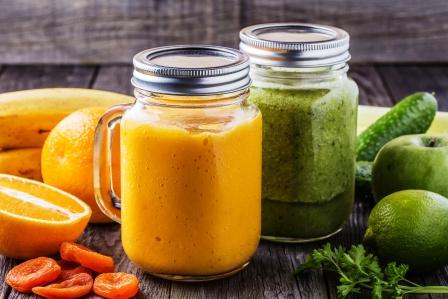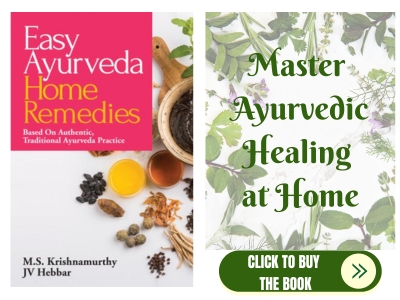Swarasa – Fresh Juice Extracts of Herbs
Article by Dr.B.K.Prashanth M.D (Ayu), Ph.D
The word Swarasa denotes fresh extract of the herb, in liquid form. It can be from any part of the plant like fruit, leaf, flower, roots etc. Acharya Charaka has also said that any juice extracted from part of the plant using any mechanical force is called Swarasa.
यन्त्र निष्पीडितात् द्रव्यात् रसः स्वरस उच्यते । Charaka Samhita Sutrasthana 4/7
Also Acharya Charaka has told that the juice of a plant can be obtained by cutting or tapping the root of a big tree and collecting the liquid oozing out of it.
Table of Contents
Ayurvedic dosage forms
There are five basic dosage forms as per Ayurveda.
swarasa (juice),
kalka(paste),
kwatha (decoction),
hima(cold infusion) and
phanta (hot infusion).
Swarasa is also considered as the most guru (heavy) for digestion among all the panchavidha kashaya kalpana, as per Chraka.

Acharya Sharangadhara has explained the concept of swarasa in detail. His explanation about different types to prepare swarasa gives a broader meaning to the word swarasa. He has told 4 different methods.
Swarasa preparation methods
1st method of making Swarasa
Fresh part of the plant, devoid of any disease, infestation is collected.
It is crushed using mechanical force like pestle and mortar or the juicer of present day.
The extracted juice is filtered using a clean cloth or sieve. Example- juice from tulasi (Ocimum sanctum Linn.), ardraka (Zingiber officinale Roxb.)
आहतात्तत्क्षणाकृष्टाद् द्रव्यात्क्षुण्णात् समुद्धरेत् ।
वस्त्र निष्पीडितो यः स रसः स्वरस उच्यते ॥ Sharangdhara Samhita Madhyama Khanda, 1/2
सद्य: समुद्धृतात् क्षुण्णाद् यः स्रवेत् पटपीडितात् ।
स्वरसः स समुद्दिष्ट: ॥ अष्टांग हृदय कल्पना ६.९
यस्मिन् दिने समुद्धृतं तस्मिन्नेव दिने प्रक्षाल्य
क्षुण्णं पीडितञ्च यद्द्रव्यं तस्य रसः स्वरसः । इति (हेमाद्रि)
Whichever the day, the fresh herbs are collected, on the same day, the fresh juice from them has to be extracted.
Kshunnat – pounding / grinding
Vastra Nishpeedita – filtered with force, with a clean cloth
2nd method of Swarasa preparation:
In case of part of plant which is soft and dry in nature, the part should be crushed and soaked in twice the amount of water overnight. Next morning the plant is macerated and filtered using a cloth. Example- extract of dhanyaka beeja (seeds of Coriandrum sativum Linn.)
कुडवं चूर्णितं द्रव्यम् क्षिप्तं च द्विगुणे जले ।
अहोरात्रं स्थितं तस्माद्भवेद्वा रस उत्तमः ॥ Sharangdhara Samhita Madhyama Khanda, 1/3
3rd method of juice extraction:
In case of a dry part of the plant where extracting the fresh juice is difficult, the plant is crushed and added with 8 parts of water. Then the mixture is taken in a vessel, boiled and reduced to 1/4th of the original quantity and filtered using a cloth. Example- extract from Ashoka bark (Saraca asoca Roxb.)
आदाय शुष्कद्रव्यं वा स्वरसानामसम्भवे ।
जले अष्टगुणिते साध्यं पादशिष्टं च गृह्यते ॥ Sharangdhara, Madhyamakhanda, 1/4.
चूर्णानां आढकमुदकस्याहोरात्रस्थितं मृदितपूतं स्वरसवत् प्रयोज्यम् । (स्वरसानामलाभे त्वयं स्वरसविधि: ।)
(च.चि.१.२.१२)
4th method: Putapaka method:
This method is called as ‘putapaka’ method. The method is followed where, even with the herb being fresh in nature, extracting the fresh juice in large quantity is difficult. The herb is cut into small pieces and covered with a big leaves of trees like
palasha (Butea monosperma Lin.),
Vata (- Banyan tree – Ficus bengalensis Linn.).
The idea behind selecting these leaves are that these leaves should sustain heat for duration of time without burning the herb inside. The leaves are tied with a thread and covered with a thick layer of clean mud. This is made into bolus shape. After drying this under sunlight completely, it is subjected to mild fire from all the sides till the ball turns to red hot. Then the bolus is left for cooling. Later the herb is collected from inside the bolus after breaking it open and the juice is extracted by pressing.
Putapaka method
Putapaka method in short –
The herb ->cut into small pieces -> covered with a big leaves of trees like palasha / banyan -> rolled into a ball, tied with threads, wrapped with mud layer (Multani mitti smeared on cloth). -> Dry -> burn -> take out the herbs -> squeeze -> juice extract.
पुटपाकस्य कल्कस्य स्वरसो गृह्यते यतः।
अतस्तु पुटपाकानां युक्तिरत्रोच्यते मया ॥
पुटपाकस्य मात्रेयं लेपस्याङारवर्णता ।
लेपं च द्वयंगुलं स्थूलं कुर्यादंगुष्ट मात्रकम् ॥
काश्मरी वटजम्ब्वादि पत्रैर्वेष्टनमुत्तमम् ।
पलमात्रं रसो ग्राह्यः कर्षमात्रं मधु क्षिपेत् ॥
कल्कचूर्ण द्रवाद्यास्तु देयाः स्वरसवद्बुदैः ॥ (वैद्यक परि.प्र.)
द्रव्यमार्द्रं शिलापिष्टं शुष्कं वा सजलम् ततः ।
गोलं विधाय वृक्षाणां पत्रैरावेप्टयेदू दृढम्॥
सूत्रेण बध्वा गोधूमपिष्टेन परिवेष्टयेत् ।
तत आर्द्रमृदालिप्त्वा गोमायाग्रौ प्रतापयेत् ॥
अङ्गरवर्णा च मृदं दृष्टूवा वह्रे समुद्धरेत् ॥
ततो रसं वस्त्रपूतं पुटपाकं प्रदापयेत् ॥ (द्र.गु.वि., श्री यादवजी)
पुटे पक्वस्य द्रव्यस्य स्वरसो गृह्यते यत: ।
आतोऽयं पुटपाकः स्याद् विधानं तस्य कथ्यते ॥ (परि. प्रदीप)
Prakshepa Dravya
Prakshepa – extra ingredients added for enhanced benefits:
मधु श्वेतागुडं क्षारान् जीरकं लवणं तथा ।
घृतं तैलं च चूर्णादीन् कोलमात्रं रसे क्षिपेत्(शा.सं.म.१.६)
घृतं सितां क्षौद्रं कोलमात्रं रसे क्षिपेत्।|
लवणक्षरचूर्णानि योग्यमानानि दापयेत् ॥(श्री यादव जी)
Based on requirement, to the Swarasa, honey, white Jaggery, Kshara, cumin seed powder, black salt, ghee, oil or herbal powders can be added in a dose of 1 Kola – 6 grams.
Example of Putapaka Swarasa – Vasa (Adhatoda vasica)
पिष्टानां वृषपत्राणां पुटपाकरसो हिमः ।
मधुयुक्तो जयेद्रक्तपित्तकासज्वरक्षयान् ॥ (शा.सं.म.ख)
The Putapaka Swarasa extracted from Vasa – Adhatoda Vasica, is adminsitered along with honey, is useful in the treatment of
Raktapitta – bleeding disorders
Kasa – cough, cold
Jwara – fever
Kshaya – emaciation, depletion of body tissues.
Analysis of different methods of Swarasa preparation:
By using the 1st method, the active principles can be obtained by extracting the juice of the plant. But in plants which are soft, the 2nd method is followed. Here, by soaking the plant in water overnight, the active ingredients which are in the part of the plant gets soaked in water. The next morning when the plant is macerated, the principle is released due to the mechanical force.
In dry herbs, since the above 2 methods are not sufficient to extract the principles, the 3rd method is followed. By boiling the part of the plant in water, it is exposed to a quantum of heat for a sufficient time, due to which the active principles are released into the water when the water is reduced. But precaution should be taken that plants having volatile principles are not subjected to this method as exposure to the heat may destroy the principles present. Examples- buds of lavanga – Clove (Syzygium aromaticum Linn.) should not be subjected for this method to extract active principles.
The 4th method is adopted when sufficient quantity of fresh juice cannot be extracted by mechanical force from a fresh plant. By putapaka method the plant becomes soft after exposure to heat and extracting the juice is comparatively easier.
The above methods give a clear indication that the word swarasa is not only fresh juice of a plant but also the extraction of the active principles into liquid media like water.
Dose, Uses
Dose:
24 ml of juice which are extracted by the 1st and 2nd method as they are guru (heavy) for digestion.
48 ml of juice which are extracted after exposing to heat. (3rd and 4th method) as they are comparatively laghu (light) for digestion
Uses of swarasa: swarasa is used for many purposes in the field of ayurveda. Depending upon the herb from which it is prepared, based upon the disease in which it is given, based upon the preparation of a medicine like tablet etc. the uses varies.
- As medicine. Example- Tulasi swarasa (juice of leaves of Ocimum sanctum Linn.)
- As bhavana dravya. (Medium of binding agent and enhancing the property of the formulation). Example- during preparation of chitrakadi tablet, juice of dadima (pomegranate seed juice)
- As Anupana (liquid media taken with medicine). Example- juice of ardraka (Zingiber officinale Roxb.) along with tablet tribhuvana keerti rasa.
The shelf life of swarasa is sadyo sevanath i.e. it should be consumed immediately after preparation. It is spoiled if kept for more than 10-12 hours irrespective of the method used for the preparation.
Article by Dr.B.K.Prashanth M.D (Ayu), Ph.D ([email protected]) and Dr Hebbar










5 comments
Claudia
Which are the five herbs that should be used only in the form of expressed juice? A collegue tell me tinospora cordifolia and adhatoda vasica but don’t remember others Thank you
Dr J V Hebbar MD(Ayu)Author
I have not come across such a reference yet.
Both tinospora and adhatoda are used in the form of kashaya as well. (as in case of panchatikta kashaya)
harsha Vardhan
Hai doctor
I apply soak bringaraj Amla and other herbs to my scalp.
Which is more potent, fresh bringaraj- amla juice or bring raj- Amla paste prepared from powders soaked in water overnight?
By how much percentage one dosage form is more potent than other dosage form?
Dr J V Hebbar MD(Ayu)Author
Hi, bring raj- Amla paste prepared from powders soaked in water is more potent, by around 30-40 %.
Sherry Carpenter
Hello Doctor,
Is there a text or a book that you could refer me to that talks about the individual herbs that can be made into juice form? I am currently a student of Ayurveda. I would love to know more on the subject!
Namaste,
Sherry Carpenter